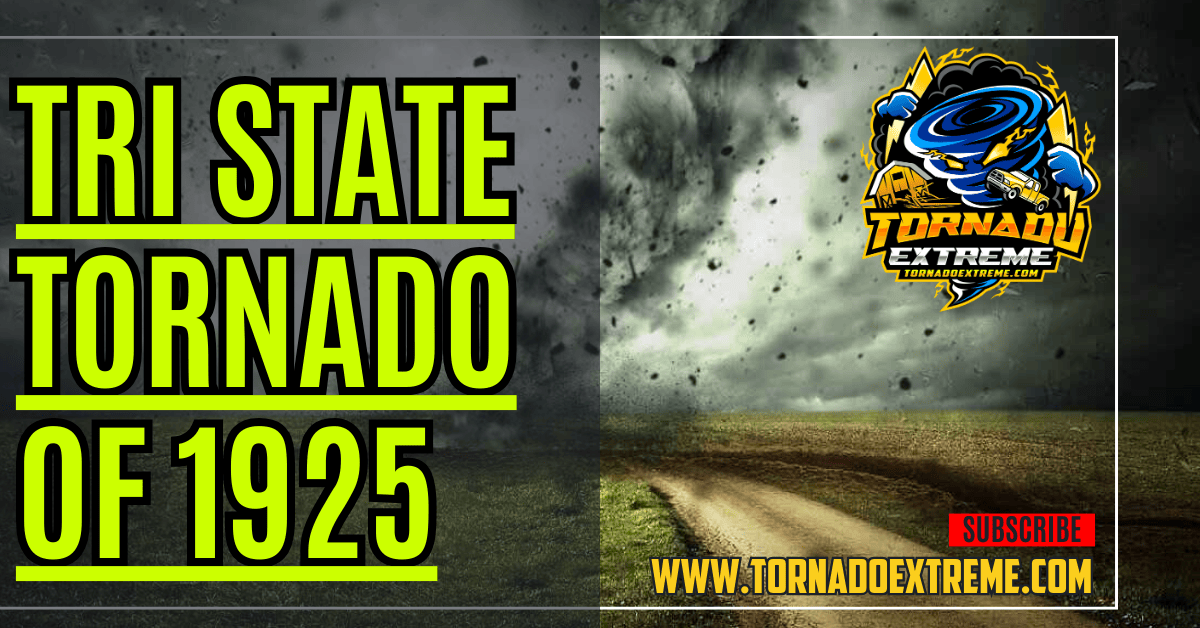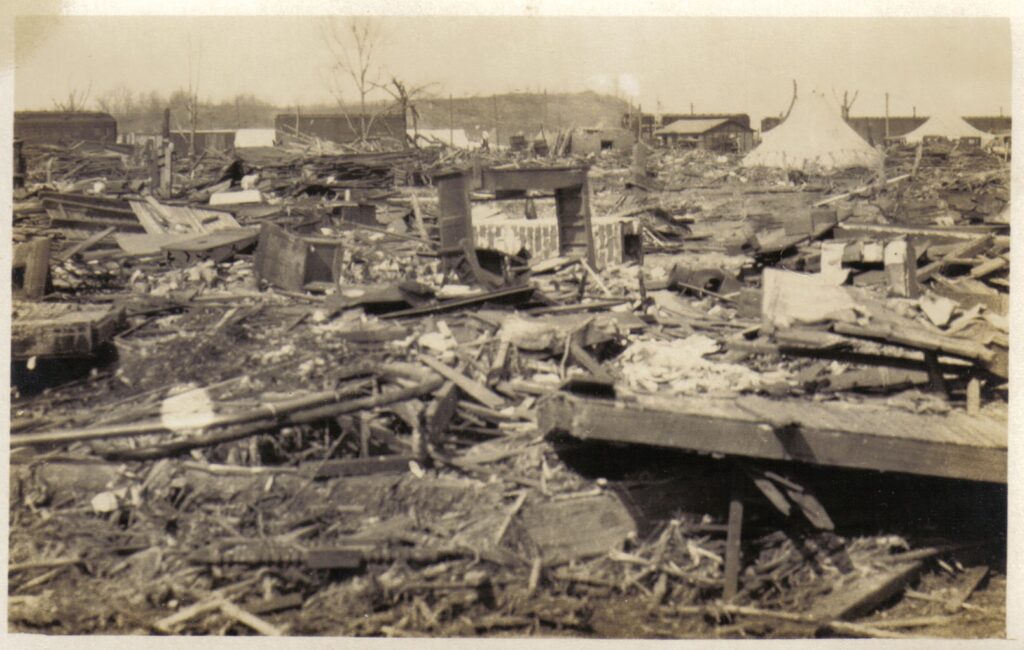Introduction to Tri State Tornado of 1925
The Tri-State Tornado in 1925 is the most deadly and destructive tornado ever recorded in the United States. It tore through Missouri, Illinois, and Indiana with an estimated wind speed of 300 mph, marking it as one of the few F5 tornadoes with such destructive power. The gusts raged across communities with unimaginable strength that leveled everything in its path. What sets this twister apart from others though is its astronomically long track length — approximately 219 miles, which has yet to be surpassed.
Nearly a century later, the impact of this catastrophe still lingers as a chilling reminder of how powerful nature can be. The scale and devastation caused by this event helped shape our understanding of tornadoes and revolutionized future disaster preparedness’ for generations to come. And it’s all thanks to lessons learned from this historic event that modern emergency response protocols exist today — so as to minimize damages brought upon by future tornadoes.
Where did the Tornado Occur?
Missouri, Illinois, and Indiana are three regions that ring a bell when thinking about where the Tri State Tornado occurred in 1925. These areas were plagued by the twister that swept up small towns and rural areas along a path nearly 219 miles long. The sheer power behind its development took many off guard, worsening their dreadful experience even more.
Homes crumbled into rubble, loss overwhelmed entire communities, while survivors tried their best to wrap their heads around the extent of destruction left behind. This tragedy managed to prove just how fragile humanity was when faced against such overwhelming forces mother nature possesses.
Despite such gloomy atmosphere there shone a ray of hope that people held onto like no other; one that allowed them to take action immediately after such an event took place.
Emergency responders quickly mobilized themselves on site and offered support/aid wherever needed around those affected neighborhoods. Brave volunteers tirelessly dug through debris hoping they’d find any survivors buried underneath all the wreckage. Medical professionals set up makeshift clinics to care for the injured, giving them a small amount of comfort in their darkest days.
The response didn’t stop just within these three states, it also reached out to areas like West Frankfort which suffered greatly. The global community also chipped in to offer humanitarian assistance and sent relief supplies over. Donations poured in from every corner of the world as all those who watched the news empathized with the pain felt by those directly impacted. Acts like these know no borders or language barriers, making them ever-so-heartwarming yet humbling at the same time.
Weeks turned into months as families and communities, including those in West Frankfort, slowly began to put the pieces back together again after the devastating F5 tornado. Temporary shelters were constructed so that displaced families had some sort of roof over their heads — even if it were only for a brief moment. Plans for rebuilding homes began circulating and were soon put into action.
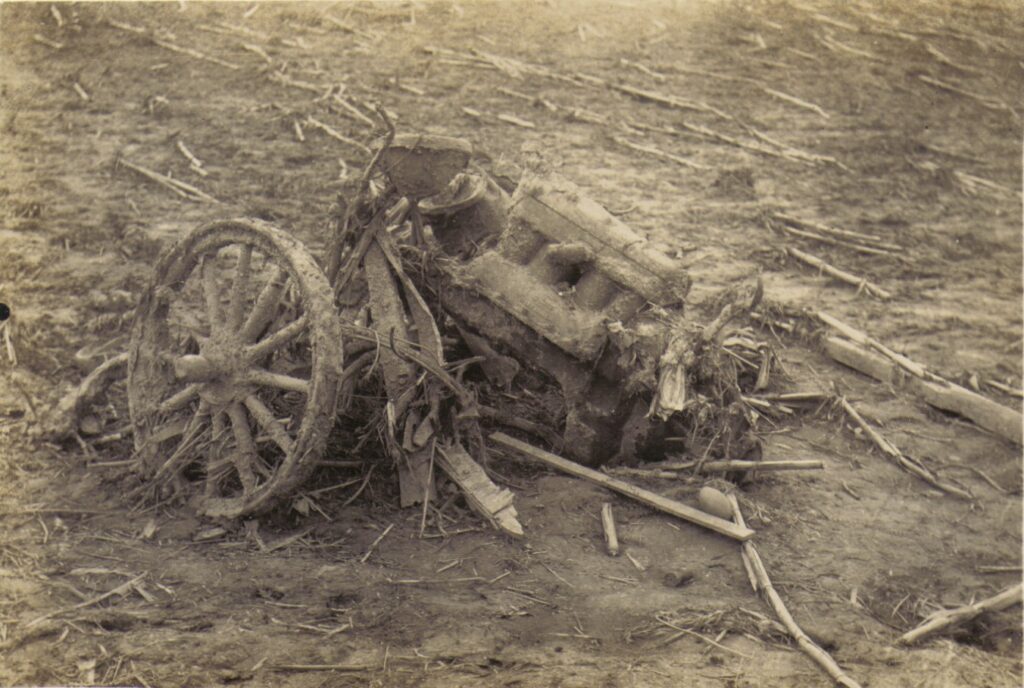
General Tri-State Tornado Facts
On March 18th, 1925, the deadliest tornado, categorized as an F5 tornado, tore through Missouri, Illinois, and Indiana with an unfathomable death toll of 695 lives lost. This incident not only made it a record holder for being the deadliest but also how quickly it traveled; covering nearly 219 miles in just 3.5 hours.
The tornado’s estimated wind speeds of 318 mph made it an F5 on the Fujita scale, the highest level of intensity. Along its path, the storm completely wiped out several towns and injured more than 2,000 people. The tornado moved so quickly and erratically that finding shelter was nearly impossible for many in its way. It remains the most violent and farthest-traveling tornado ever recorded.
See also: Which State Has the Most Tornadoes and Why It Matters
Tri-State Tornado Records
Occurring on March 18, 1925, the Tri-State Tornado holds two world records: longest continuous track by any tornado (219 miles) across Missouri, Illinois and Indiana; fastest recorded straight-line winds in a tornado (301 mph).
It is also one of the deadliest storms in U.S. history. With a death toll of 695 people, it ranks as the nation’s deadliest single tornado event, an F5 tornado that left an indelible mark on the history of natural disasters. In addition to leveling entire towns, it caused unprecedented destruction.
The storm also changed weather forecasting and warning systems forever. What happened on March 18, 1925 led to better preparedness for severe weather events today.
Death Totals by State for Deadliest Tornado on Record
State-By-State Death Toll
Missouri – More than 600
Illinois – More than 500
Indiana – More than 70
The Tri-State Tornado that struck Missouri, Illinois and Indiana in March of 1925 killed an estimated total of at least 695 people — making it not only the deadliest single tornado event in U.S. history but one that carried exceptional destructive power across three states.
In Missouri alone, more than half of those who died from this disaster were residents. The total was well over six hundred fatalities there — making it easily this country’s record-holder for deaths directly attributable to a single twister.
Across all three states combined this monster cyclone virtually blew away entire communities within minutes time — leaving behind only mounds of rubble and debris.
Illinois suffered as well, with more than 500 known fatalities. In towns like Murphysboro and Gorham, where multiple blocks were reduced to piles of splintered lumber that was randomly mixed with unrecognizable remains, the survivors’ only option was to weep over the horrifying sight that saturated them with immense grief.
In Indiana, there were around 70 deaths recorded. But this small number does not mean that it experienced any less destruction than Missouri or Illinois — it simply means that there were fewer people in the tornado’s way.
The storm’s grotesque trail of casualties is a reminder of its colossal power and toll on these states and their residents. People from across all three areas, including those in West Frankfort, will forever remember the impact it had on their lives during those chaotic days.
For those caught in its wrath, time seemed to slow down. What should have been a mere few hours felt like days, which turned into weeks of unimaginable grief and loss. People questioned how something so terrible could occur — but nature doesn’t care about human life when it unleashes its full fury.
As one might expect for a storm with such duration and distance covered, the Great Tri-State Tornado of 1925 holds numerous records associated with deadly storms in America. Sustaining windspeeds between 250 mph (402 km/h) to possibly over 300 mph (483 km/h), this single event left an indelible mark on communities and our understanding of these frightening phenomena.
Human casualties from the tornado are similarly terrifyingly high: nearly 700 confirmed fatalities with thousands more injured or without homes due to the effects of this monstrous weather system.
It is soothing to know that man has come a long way since then, all thanks to improved research efforts since this nightmare.
One thing that really draws attention is just how long the Great Tri-State Tornado of 1925 lasted. The monster storm spun for a record-breaking 3 hours, 30 minutes, and traveled at a speed that was equivalent to about two-thirds the speed of a cheetah running at full tilt.
Also astonishing is that it’s difficult even now to find tornadoes with a continuous path as long as this one. The three-state tornado started in Ellington Missouri on March 18, 1925, passed through southeast Illinois and finally dissipated near Petersburg.
See also: What Is a Multi Vortex Tornado? A Comprehensive Exploration
Death Total by State for the Worst Tornado in US History
The Tri-State Tornado of 1925, which tore through parts of Missouri, Illinois and Indiana, killed an astonishing 695 people. The numbers in Missouri were staggering, with more than 600 dead, making it the deadliest state in this catastrophic storm. Entire communities were wiped out within minutes.
Illinois suffered a deadly blow as well: More than 500 deaths are attributed to the tornado. Towns like Murphysboro and Gorham were left in ruins.
Indiana had over 70 deaths. This unprecedented death toll not only underscores the incredible power of the natural disaster but is also a grim reminder of its enduring impact on these states and their communities.
Here is how we covered the aftermath at the time:
“Murphysboro was struck by death,” an April 1 article says. “In that community alone at least 200 persons lost their lives…” Streets were lined with homes and businesses now reduced to rubble and debris. A silence hung in the air, broken only by a siren wailing from another part of town or by a fire engine racing through streets that had been crowded with life before nature’s wrath descended upon them.”
Rescue workers searched for survivors buried beneath buildings that moments earlier had been thriving centers of commerce.
“The tramp-tramp noise came again,” The Times wrote on March 20 about Murphysboro. “The lid of one tomb was lifted up.” Then there was movement inside: “A woman’s head appeared above its rim… ‘Hurry! Hurry!’ She screamed…”
Elsewhere in that city grew more makeshift morgues filled with bodies, and more beds where doctors worked frantically to save those who could be saved.
“Last night I walked through miles of ghostly ruins where once two prosperous towns stood,” one reporter wrote two days after the storm hit Illinois. “…I stopped in a pool of light from a street lamp, and looked back over the terrible way I had come.”
In many places, residents were still missing, their loved ones awaiting news while living in shelters or with relatives.
“Many refugees were huddled near the wrecked homes they had hoped to find still standing,” an April 1 article says about Gorham. “A few hundred yards away another group sat around a bonfire built on the wreckage of a business section that now was home for hundreds…”

About The Tri State Tornado
The 1925 Tri-State Tornado was a completely different beast in comparison to the other twisters. As it tore through parts of Missouri, Illinois, and Indiana, people were dumbfounded at the average speed and the destructive power of this F5 tornado. When it crossed the Wabash River, entire towns were wiped out and thousands found themselves laying lifeless after its path of destruction that spanned across three states, marking it as a devastating F5 tornado. The scariest part? The tornado remained active for more than three hours.
Nowadays we have tornado warnings, systems to protect against these events and people are a lot wiser when it comes to tornados. But back then there was none of that stuff because nobody really knew how bad these things could get or what they even were for that matter. After this disaster we made substantial progress in both research about tornados and measures that would increase public safety.
The first official tornado warning system in the United States didn’t come until many years later in 1950 after the Tri-State Tornado leveled countless homes and took many lives. This system tracked storms using radar technology and issued warnings to residents so they could take shelter.
We can also thank this twister for advancements in forecasting and prevention methods as well which helped us achieve a better understanding about how these things work. With new knowledge about these powerful natural disasters came new measures so we wouldn’t be caught off guard again, such as Doppler radar tech which checks storms’ severity.
But perhaps one of the best outcomes from this tragedy is that it changed the way buildings are constructed, as well as building codes and construction practices too so that buildings could withstand tornado winds to an extent instead of crumbling under them like tinder paper.
It’s crazy how something so destructive can lead to such great change — but at least now we’re prepared when future storms start brewing on our doorstep.
See also: Green Sky Tornado: Why Does the Sky Turn Green?
March 18th, 1925: A Day the World Would Remember
As news of the tornado’s approach spread throughout communities along its predicted path, people panicked. Communication systems were limited back then so warning residents were tougher than it would be today — but still possible nonetheless, even as the tornado lasted, devastating towns like West Frankfort. Many people in towns and villages were caught off guard because they had never witnessed such an immense force of nature before.
It struck Mississippi at around noon local time, moving eastward from there into southern Illinois by mid-afternoon and into southwestern Indiana by about dinner time, according to John Wetter with the National Weather Service (NWS) office in Paducah Kentucky.
The 1925 Tri-State Tornado left behind a path ever-lasting impact on many of the survivors. The destruction was unprecedented and to this day it is still regarded as the most catastrophic tornado in US history. Being the only recorded tornado to travel over 200 miles, it traveled 219 miles across three states and destroyed everything in its path. In addition, its wind speed reached an estimated 300 mph, no other natural disaster has produced a stronger gust.
The tornado struck during a late winter afternoon when people were still at work or school. This caused them to be caught off guard and made them more vulnerable against its force. It is typically rare for a tornado to happen in the winter since they are normally associated with spring and summer months.
During that time there were little advanced warning systems and emergency response protocols available than what we have today so officials were ill-equipped to mitigate its impact or protect their residents effectively. Add that factor onto inadequate infrastructure and building standards for severe weather resilience and you have your recipe for a catastrophic event.
Another equally interesting thing was that during the teldo of this tri-state attack it was illegal to publish or broadcast tornado predictions! Authorities were afraid that sharing such news would cause pandemonium among the public which could result in even worse outcomes. This means that warnings weren’t shared until the very last minute, giving people no time to react appropriately.
Why was this Tornado so Catastrophic?
Widely regarded as the most catastrophic tornado in US history, the Tri-State Tornado of 1925 tore a path of destruction through three states. It went where no other had gone before or since — that’s no small feat given its unprecedented length of 219 miles. The scope and scale meant countless communities were mowed down and people unprepared to die now would.
The timing and speed of the cyclone are also to blame. The twister hit the ground during late afternoon, when many were still at work or school — leaving them vulnerable to its wrath. And this wasn’t some ordinary windstorm: With gales reaching an estimated 300 mph, it blew away any hope they had of surviving.
Of course, the lack of advanced warning systems and emergency response protocols didn’t help matters. With little ability to predict such an immense disaster or plan for one, these communities could only watch in horror as it struck. That fear was compounded by inadequate infrastructure and building standards designed to withstand severe weather: There simply wasn’t much they could do except pray that it would all be over soon.

The Tornado Occurred in Winter
It was an especially cold and unexpected event. Typically, tornadoes happen during spring and summer, so the late winter arrival of the Great Tri-State tornado in 1925 caught everyone off guard. The cold, white landscape further highlighted how quickly nature could turn from beauty to chaos. It is a sight that those who witnessed have said they’ll never forget.
This unusual timing also made it hard for rescue teams to get to work. With roads frozen over and covered with inches of snow, it was tough to get anywhere at all. But communities banded together and fought to get their neighbors out alive while freezing temperatures lingered.
Yes, you read that correctly. In 1925, it was illegal to publish or broadcast a tornado prediction. You might be wondering why anyone would ever pass such a law. Well, officials at the time learned about another disaster that happened when newspapers falsely predicted danger, causing a panic among readers who were all just fine.
But this ban on sharing predictions raises many questions about what should be done in times of danger like this one. Sure, they didn’t want everyone freaking out when nothing was going to happen — but nobody had any idea what was coming for them until it was too late (like right ’til it killed ’em). We’ve learned a lot since then about weather forecasting and communication methods during emergencies, so maybe there wouldn’t be quite as much destruction if we were better prepared today?
What’s more interesting is that the Tri-State Tornado may not have even been visible at all!
A tornado is a column of air that often forms when there’s a severe thunderstorm. It gets its iconic shape because the surrounding storm traps it and causes it to spin. The Tri-State Tornado of 1925 was one such event, but with over 400km/h winds and lasting for 3.5 hours, it was anything but routine. In fact, to this day, no other tornado has been more devastating than this one.
Emergency services were not as efficient in 1925 as they are today, so rescue efforts took time. It wasn’t until days later that people started uncovering entire towns that had been completely wiped off the map. The death toll continued to rise for weeks after the tornado had dissipated, and when all was said and done, the catastrophe took over 700 lives.
Furthermore, when taking into account inflation and the cost of damages at the time, the Tri-State Tornado of 1925 easily surpasses even Hurricane Katrina on the list of most financially destructive natural disasters in American history.
It should be noted that while researchers have concluded that this specific tornado occurred naturally, many suspect humans may have inadvertently played a part in why this particular severe thunderstorm produced such an extreme force within itself.
There is some evidence to believe this could be true – during World War I there were thousands of tanks built by both sides using many dangerous chemicals which were blown up or abandoned across numerous battlefields globally. Consequently, some think that certain areas experienced greater accumulations of these pollutants over time than others did due to localized wind patterns caused by battles waged throughout WWI.
As bizarre as it sounds though, none of these theories hold much weight in terms of scientific consensus since we aren’t even sure if human activity would be capable of creating a situation where a thunderstorm is vastly more destructive than one would expect based solely upon weather patterns.
The Tri State Tornado of 1925 made it crystal clear how terrible the emergency systems were at this time. I mean, come on! They had limited communication and knowledge when it came to severe weather patterns. So, yeah, there was no way they could handle a disaster like this one.
Compared to today’s 1.6 advanced technology and preparedness, emergency services in 1925 were ill-equipped to handle the scale and intensity of natural disasters like the Tri-State Tornado that crossed through different States.
A lack of standardized training for first responders and incapability in disaster management protocols further complicated things during the tri-state disaster. Unlike modern times where paramedics, fire departments, and law enforcement are better equipped, back then the communities hit by the F5 tornado had to rely on minimal resources to rebuild and recover. Nah man… those resources just weren’t available during these times.
As a result, there was little organization within agencies involved in providing emergency services during the 1925 tornado. This lead to disarray in places like Ellington where it became difficult – or impossible – to rescue people from dangerous situations.
The Tornado Took a Peculiar Path
The Tri State Tornado of 1925 was a tornado that had a very erratic path, as it moved through communities in Missouri, Illinois, and Indiana. It is said that the 1925 Tri-State tornado stood out mainly because of its unpredictable behavior and defying path. In other words it kinda did what it wanted to do and didn’t follow the typical straight trajectory. It crossed paths that most tornadoes never cross which added a level of terror and chaos for the people trying to come up with an escape plan.
There have been many theories about why this tornado decided to act so strange. Some suggested that maybe there was something going on with local topography or atmospheric conditions but none have been confirmed. The one thing that has been confirmed is just how unpredictable and powerful nature can be sometimes. This disasterous tornado has left a lasting impact on those who witnessed its rath through their towns.
There may have been Multiple Tornadoes
There have been discussions over whether there were multiple Tornadoes at once during the Tri-State Tornado outbreak sequence in 1925 across Missouri, Illinois, and Indiana. This would help explain its wide-ranging destruction which scared all three states for the worst reason possible.. During this event multiple twisters form when their storms are close by each other during the same storm system.
It’s still being looked into weather or not this could’ve been one massive twister or multiple but these new insights give us new meaning into just how bad it was and challenges our understanding of its behavior… To think there were two, three even four massive funnels in such close proximity would make your brain explode if you really thought about it.. Now all we can do is ponder about what really happened on March 18th, 1925
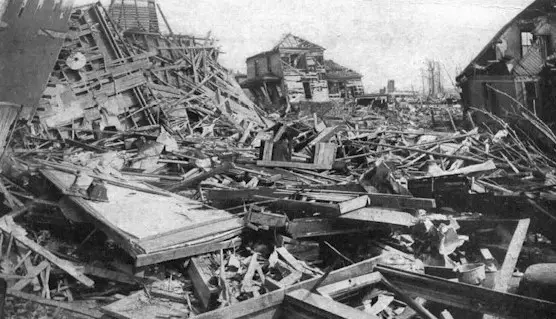
source: Jackson County, IL Historical Society / NOAA
Emergency Services were not as Efficient as They are Today
The Tri-State Tornado that occurred in 1925 paved way for the realization that emergency services at the time were just too slow. With a poor communication system and very low knowledge on dangerous weather patterns, it was difficult to respond adequately to this kind of devastating event. Compared to today’s 1.6 advanced technology and preparedness, it is clear that emergency services in 1925 could not handle natural disasters like the Tri-State Tornado that crossed through different States.
Not only did first responders lack standardized training, but there were also no disaster management protocols in place when the tri-state disaster happened. Unlike now where paramedics, fire departments and law enforcement undergo rigorous training with specialized equipment to help them swiftly respond to emergencies, these crucial resources lacked during the time of this historic tornado. Places like Ellington even faced disorganization and limited coordination among different agencies involved in providing emergency services thus hampering rescue efforts during the 1925 tornado.
And while we are still trying to figure out if there were multiple tornadoes during the Tri-State Tornado, scientists and other experts need to continue researching these natural disasters so as to understand them better. For instance, by figuring out how a tornado lasted for an unprecedented time of over three hours during this event will go a long way into helping us enhance early warning systems and understand how we can mitigate such destructive effects in future.
Amazing Stories of Survival
1. Out of the countless tales of resilience and human survival, four stand out as beacons of hope. Juliane Koepcke is the first on that list when she survived a plane crash in 1971, and navigated the Amazon rainforest for 11 days before being rescued, an example of human resilience similar to those who rebuilt their lives after the massive F5 tornado in 1925. The survivors of the 1925 tornado showed us what humans are capable of when faced with death. They managed to make it through while almost 700 people died.
2. Aron Ralston’s story is also an incredible one. He cut off his own arm to free himself from under a boulder while hiking alone in Utah’s Blue John Canyon. This wasn’t just willpower though, he’s also really quick on his feet and pretty courageous too.
3. Beatrice Biira, a young Ugandan girl who grew up poor dealt with her situation by using education as an escape route. Her story might remind you a little bit of Malcolm X if you’re familiar with him at all.
4. Last but not least is Joe Simpson, who had to fight for survival after breaking his leg high up on a frozen mountain peak while mountaineering in Peru. If you know anything about mountaineering then you’d know that these aren’t ideal conditions to be stuck in let alone survive, much like how survivors managed after the F5 tornado demolished their towns.
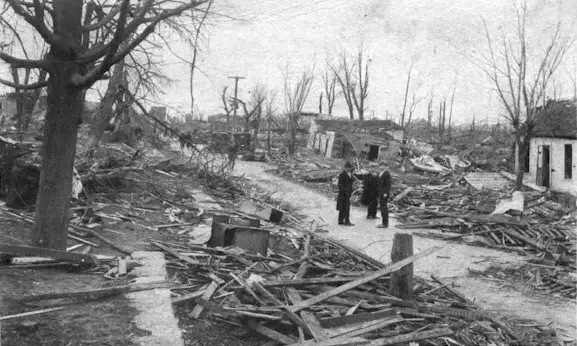
source: Jackson County, IL Historical Society
Tri State Tornado pictures
Due to how long ago this event took place there aren’t any photos available of the tornado itself but we do have some after photos that show some pretty insane destruction caused by this historic storm.
The photos show entire towns leveled and debris scattered for miles around them. They capture rescue efforts being made along with complete shock on everyone’s face because nobody expected something like this to happen at all let alone where they were living.
We still don’t quite understand nature’s true power even today but these pictures are a good reminder of how strong and weak we can be at the same time.
Tri State Tornado Facts
The Tri-State Tornado that made its way through Missouri, Illinois and Indiana on March 18th, 1925 is actually still the deadliest tornado in US history. It flattened over 200 miles of land and claimed nearly 700 lives. The width of it was so big and strong that Meteorologist’s understanding of tornados had to be completely re-evaluated afterwards.
Also, the Tri-State Tornado exposed a severe lack of preparedness. In 1925, many communities didn’t have an emergency response system to deal with such natural disasters. But after the 352-mile long tornado wiped out towns like Princeton, they were quick to install a warning siren and create a committee to address future threats. Nowadays, when we often grapple with the concept that severe weather is growing more frequent and destructive, it’s important to remember how this event shifted our collective understanding of tornadoes and disaster preparedness.
• The most deadly tornado in US history was the Tri State Tornado of 1925.
• It occurred on March 18, 1925 in Missouri, Illinois, and Indiana.
• The twister traveled approximately 219 miles — one of the longest recorded paths for a tornado.
• It killed at least 695 people and injured thousands.
• The devastation caused by the Tri-State Tornado led to advancements in forecasting and safety precautions, helping predict future F5 tornadoes with greater accuracy.
Final Thoughts About the Worst Tornado in US History
1. Just thinking about what happened during that day back in 1925 will leave you in awe at nature’s power. For survivors to push forward through such incredible destruction shows a lot about human resilience when faced with unimaginable adversity. This event demonstrates how important community support and disaster prepping are when trying to mitigate damage from natural disasters like an F5 tornado. Which makes you think: How well would your community handle something of that scale today? Humans have done what they can since then to improve early warnings systems and emergency response strategies but there is always more work that needs doing if we’re going to keep ourselves as safe as possible.
2.In order for us to understand how certain things work today, we need stories from those who lived through them yesterday, such as the survivors from the 1925 tornado that lasted for hours and led to 695 deaths. In this case: We should all thank whoever passed down their story from back then because without it we wouldn’t have valuable insights into individual experience during extreme weather events. This event gives context to tornado research and helps us predict their behavior better in the future so we can be as safe as possible. Acknowledging that legacy is what encourages us not to let our guard down and protect those who could fall victim again from another natural disaster.

